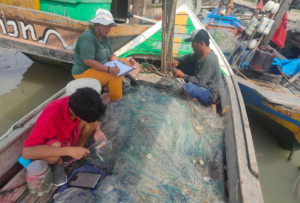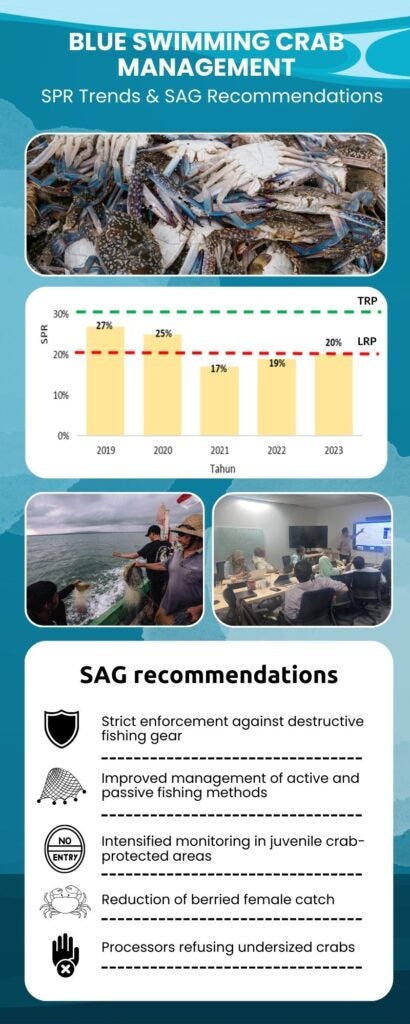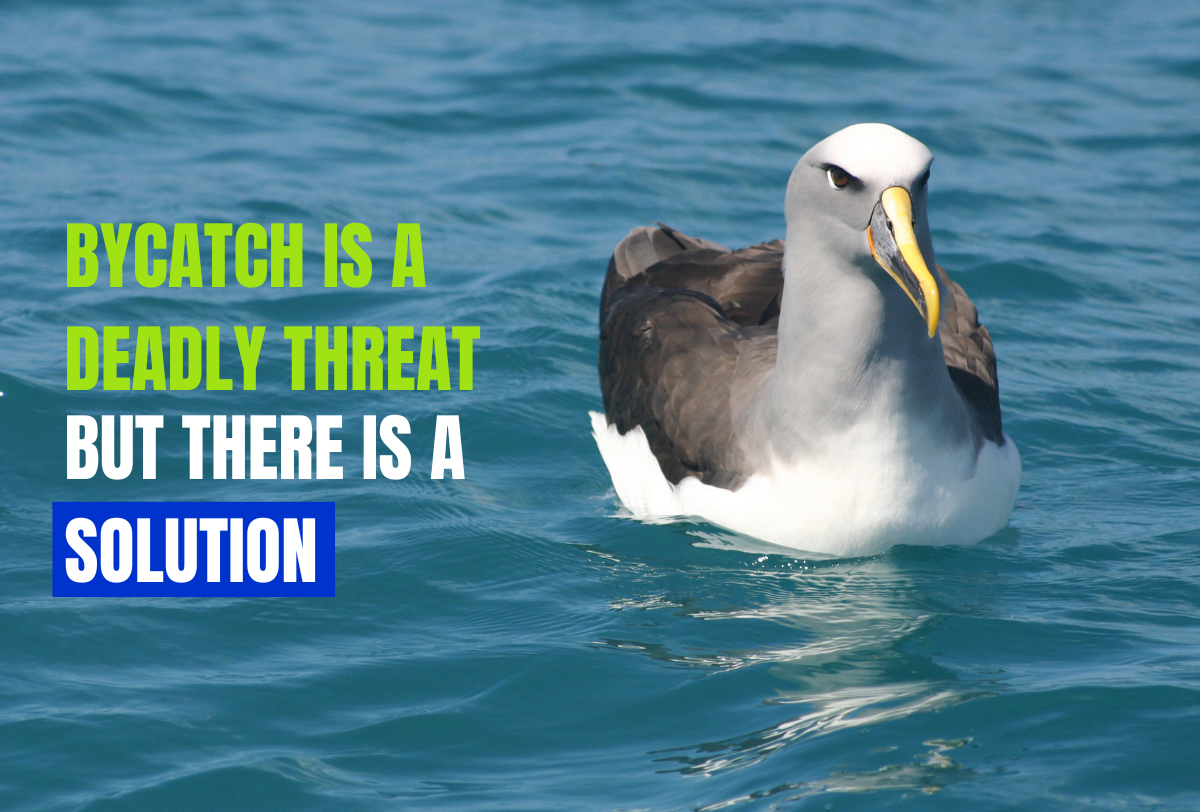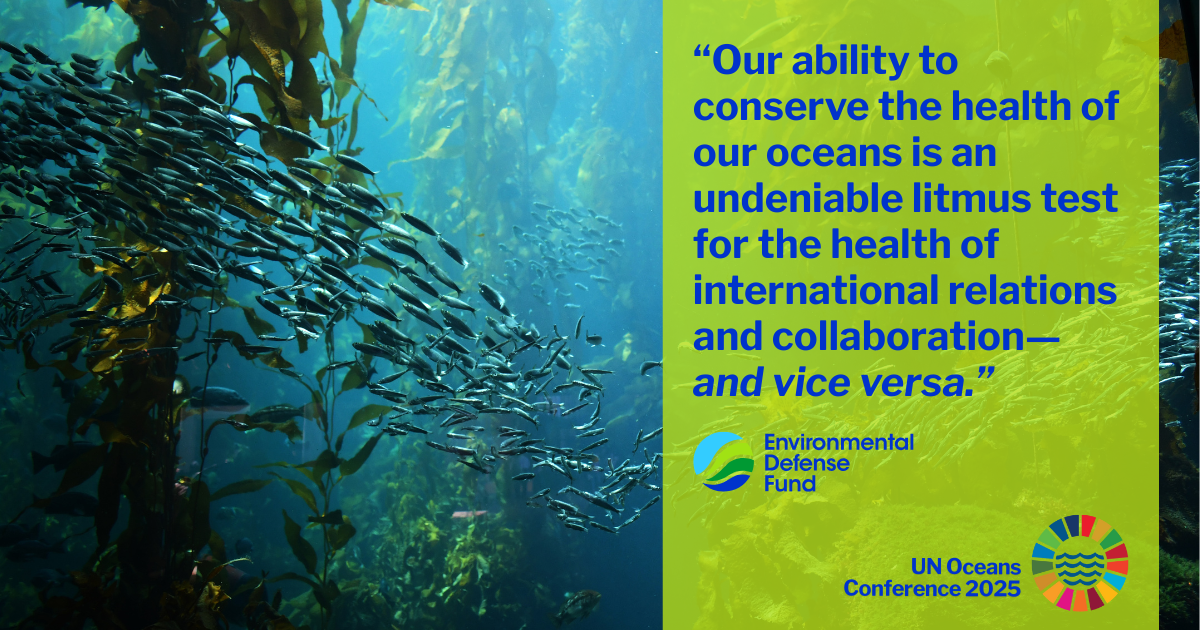
Transforming Data into Action: A Five-Year Look at Blue Swimming Crab Fisheries Performance in Lampung
By: Harlisa, M. Khazali, and Meutia Isty Wulandari
Sarkad gazed out at the Lampung coastline, his hands gripping the edge of his small fishing boat. At 49 years old, Sarkad had spent over half his life catching blue swimming crabs. He fled his hometown in West Java, hoping to escape deteriorating marine conditions and declining catches, only to find the same situation in Lampung. The abundant blue swimming crabs he remembered from 16 years ago have dwindled as a result of years of unsustainable fishing practices.
Sarkad’s story was not unique. Like him, thousands of fishers in Lampung Province depend on the blue swimming crab fishery for their livelihoods. Once a thriving industry that supported over 7,000 communities, the fishery is now on the brink of decline due to overfishing, habitat degradation, and the looming threat of climate change.
In 2017, a promising development emerged as the national and local government, in partnership with the Environmental Defense Fund (EDF), began an initiative to establish a sustainable blue swimming crab fisheries management framework. This initiative creates a comprehensive management plan with clear strategies and measurable actions for long-term success, and it is implemented by a designated co-management body, with support from local fishers and stakeholders.
During the implementation of the management plan, since 2019, performance indicators like the Spawning Potential Ratio (SPR)—a key indicator of blue swimming crabs stock health—were monitored. Armed with real-time data, the Scientific Advisory Group (SAG)—a team of experts from national research agencies and local universities—transformed raw numbers into actionable management recommendations.
The result indicates that this initiative has successfully reversed the decreasing trends of the blue swimming crab SPR in the Eastern Waters of Lampung Province for the past two years. This consistent stock assessment analysis owes its success to a robust data collection framework, initially designed following the national fisheries data collection protocol developed by the Fisheries Research Center. Expanding on this foundation, our commitment to improving efficiency and effectiveness led us to modernize the data collection process, as detailed in our previous blog post. The subsequent transformation of data into actionable insights has proven invaluable, enabling us to make informed decisions and driving tangible positive change.
As Sarkad learned about these efforts, he felt a spark of optimism. “Frankly speaking,” he said, “if data collection activities can play a role in helping to ensure the sustainability of blue swimming crab resources and the livelihoods of fishers, I’m willing to participate.” For Sarkad, this initiative represents a chance to reverse the decline he has witnessed for the past two decades.
Impressive results, ongoing challenges
Over five years of monitoring blue swimming crab performance indicators, the program has yielded impressive results. With the participation of 450 small-scale vessels, trained  enumerators gather crucial data to analyze the fishery’s health from 40,000 crab samples annually. This information, analyzed by the SAG, guides management decisions.
enumerators gather crucial data to analyze the fishery’s health from 40,000 crab samples annually. This information, analyzed by the SAG, guides management decisions.
Concurrently with the implementation of enabling conditions and management measures, the SPR initially showed a declining trend. However, a positive reversal has been evident in the past two years, with the SPR gradually increasing despite not reaching the target reference point yet. Adherence to the established control rule underscores the importance of continuing to implement action plans to maintain fishery health and, ultimately, achieve sustainable levels. The persistent enhancement of best practices in blue swimming crab management will be vital to securing the long-term sustainability of the fishery.
The Path Forward: Institutionalization
As we reflect on our five-year programs, one thing is clear: Lampung’s journey towards sustainable blue swimming crab fisheries is far from over, but the path ahead is clearer and more promising. We are now embarking on a pivotal phase—institutionalizing the data collection process. This next phase is all about empowering stakeholders to play a key part in data collection efforts and contribute to the management of blue swimming crab fisheries.
Imagine a future where local fishers like Sarkad aren’t just part of the solution; they’re leading it. With upgraded national electronic logbooks, they can record critical data, such as carapace length, to monitor the SPR. This effort is part of EDF’s commitment to support the transformation by providing the knowledge necessary to track key fishery performance indicators in Lampung Province on a long-term basis.
Sarkad and his fellow fishers are now the front-line guardians of their fishery. Each data point they record flows directly into national-level systems, creating a real-time picture of the fishery’s health. By fostering a sense of ownership and accountability, we’re not just collecting data but creating a culture of community-led initiatives that will last for generations.
The collaborative and science-based approach in Lampung offers a replicable model for other regions facing similar challenges, proving that, with the right tools and trust in local leadership, communities and ecosystems can thrive together.
Stay tuned for the next chapter of Lampung’s journey towards sustainable crab fisheries.












